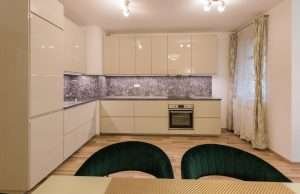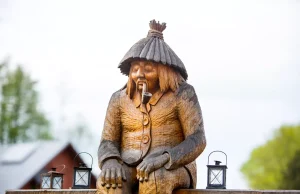You can see the original open-air gallery and the 20th century fine art gallery in the premises of the Klenová castle and chateau. Here you will find a historical exposition from the history of the castle and chateau and several exhibitions of Czech and foreign art. The castle offers unique views of the central Šumava.
Extensive ruin of an important medieval castle , to which a Neo-Gothic castle was added in the 19th century, is located 13 km west of Klatov. In the second half of the 19th century, a complete urban complex of residential and farm buildings (granary, villa, chapel of St. Felix, farm) grew up in the immediate vicinity.
You can also use the castle restaurant , named after the most important native of Klenová, the Renaissance humanist Kryštof Harant from Polžice and Bezdružice. The historic interiors provide an ideal setting for wedding receptions, associated with the ceremony at Klenová Castle, as well as for other types of social events.
Exhibition: Freely accessible castle ruinswith a wonderful view of Šumava. Ground floor of the castle: permanent exhibition on the history of the castle, Czech art of the 20th century, the work of Vilma Vrbová – Kotrbová. The first floor of the castle and Granary : exhibitions of 20th century art. The courtyard and surroundings of the castle: a gallery of modern sculptures in the open air.
From the history of Klenová Castle and its famous owners
The first mention of the lords of Klenový comes from 1287. From that time, the lower part of the northern wall of the palace and the prismatic tower in the westernmost part of the complex have been preserved. In the years 1420 – 1465, Přibík from Klenového , a famous warrior and one of the most important figures in the political life of the time, owned the ancestral seat. During the Hussite Wars, he managed to occupy Stříbro and besieged Pilsen. He also became famous for his foray into Bavaria in 1450, where he looted 600 cattle and horses. There is also a legend about him, recorded by Václav Hájek from Libočany. According to her, in 1447 he captured two Polish monks traveling to Bavaria on suspicion that they were carrying messages to Rome directed against the Kališnica bishop Jan Rokycan. He tortured them cruelly and then – so that the torture would not be revealed – he let them starve to death in the already mentioned castle prison in the prismatic tower. The most significant construction work of Přibík from Klenového was the further strengthening of the castle’s fortifications.
In the first half of the 16th century, the residence was acquired by Jiří Harant from Polžice and Bezdružice, the father of Kryštof Harant , who was probably born here. In 1594, Kryštof participated in the anti-Turkish campaign, during which he proved his military talent and loyalty to the emperor. In the spring of 1598, he left Chudenice accompanied by his brother-in-law, the knight Heřman Černín. He described the journey, which led through Bavaria and Tyrol to Italy, then to Crete, Cyprus, to Palestinian Jaffa, today’s Tel Aviv, Jerusalem and to Egypt, in the travelogue Putování or Journey from the Kingdom of Bohemia to the City of Venice , one of the most famous works of Czech literature. In 1618, for reasons that are not entirely clear, he converted to the Podoboj faith and actively participated in the Estates’ Rebellion. On June 21, he was executed on the Old Town Square in Prague for participating in the resistance. He was buried in the church tomb at Pecka Castle .
In the 19th century, Klenová was completely deserted except for a few outbuildings in the forecourt. In 1832, Count Josef Filip Eduard Stadion-Warthausen und Thannhausen bought the estate . The castle ruin was used as a romantic backdrop. Edited by Count Stadion hereviewing terrace and also erected a large prismatic tower, which he topped off with a roof with a walkway. The count further built the lower gate, set up a chapel on the floor of the upper gate, and built a carriage house in neo-Gothic style in the area in front of the large tower. In 1838, the estate was sold to František Václav Veith . He completed the castle interiors, whose decorative decoration (illusory paneling of the walls) he probably commissioned to the famous Czech painter Josef Navrátil , who also worked for him and his relatives at other places in Bohemia, for example at Jirny and Liběchov castles. Under Heliodor Heidl, who acquired the castle after 1849, the western Neo-Gothic wing was modified in the Neo-Renaissance style . The painter Vilma Vrbová – Kotrbová is listed as the last owner. In 1963, a fine art gallery was established at Klenová .
Operator Time
Gallery Klatovy / Klenová
Klenová 1
340 21 Janovice nad Úhlavou
Tel.: +420 376 392 208
- Tel.: +420 602 489 097
- E-mail: info@gkk.cz
- www.gkk.cz
Region: Pilsen Region
Region: Shumava
City: Janovice nad Úhlavou
Tips for a trip: Janovice nad Úhlavou and surroundings
Opening hours
April
1.4. – 30.4.
Monday CLOSED
Tuesday – Sunday 10:00 – 12:00
12:30 – 16:00
May – June
1.5. – 30.6.
Monday CLOSED
Tuesday – Sunday 09:00 – 12:00
12:30 – 17:00
July – August
1.7. – 31.8.
Monday – Sunday 09:00 – 12:00
12:30 – 18:00
September
1.9. – 30.9.
Monday CLOSED
Tuesday – Sunday 09:00 – 12:00
12:30 – 17:00
October
1.10. – 31.10.
Monday CLOSED
Tuesday – Sunday 10:00 – 12:00
12:30 – 16:00
Admission
Price: 80 CZK
Reduced price: CZK 40
Duration
1.0 hours










